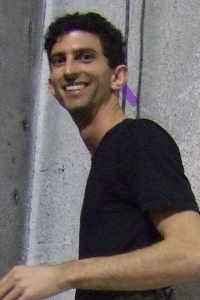

While at UCSC, I worked with James Davis on Novel Display Technologies.
Linked In.
I completed my Ph.D. in computer science at the University of California, Santa Cruz, in 2012.
As a graduate student, I interned at Microsoft Research,
National Semiconductor,
Los Alamos National Labs, and
MatterPort.
I'm often rock climbing at Pacific Edge in Santa Cruz or
Mission Cliffs in San Francisco.
I worked for a few years at General Atomics
in San Diego, making Synthetic Aperture Radars (a kind of camera) on remote-control airplanes estimate where the stuff in their pictures are.
I studied mechanical engineering as an undergrad at
Princeton.
As an undergrad, I interned at the Salk Institute's Computational Neurobiology Lab and the
Laboratoire National des Ponts et Chaussees.
3D+2DTV: 3D displays with no ghosting for viewers without glasses
Scher, S., Liu, J., Vaish, R., Gunawardane, P., Davis, J.
ACM Transaction on Graphics (TOG), 32(3), Article 21 (2013).
3D displays show 3D images to viewers wearing special glasses, while showing an incomprehensible double image to viewers without glasses.
We demonstrate a simple method that provides those with glasses a 3D experience, while viewers without glasses see a 2D image without artifacts.
Paper PDF ,
BibTex,
Download Video,
Project Web Page
Printing Reflectance Functions
Tom Malzbender, Ramin Samadani, Steven Scher, Adam Crume, and James Davis.
ACM Transactions on Graphics (TOG) 31(3), Article 20 (May 2012).
We present an approach to printing the reflectance functions of an object or scene so that its appearance is modified correctly as a function of the lighting conditions when viewing the print.
For example, such a photograph of a statue printed with our approach appears to cast shadows to the right when the photograph is illuminated from the left.
Paper PDF ,
BibTex,
Download Video,
Project Web Page
Optimized Image Sampling for View and Light Interpolation
Prabath Gunawardane, Oliver Wang, Steve Scher, James Davis, Ian Rickard, Tom Malzbender.
International Symposium on Virtual Reality, Archaeology and Cultural Heritage (VAST) 2009.
Joint View-Interpolation and Lighting-Interpolation in image-based rendering benefits from a "View First, Lighting Second" order, the opposite of the standard approach.
The optimal tradeoff between the number of viewpoints and the number of lighting conditions at each viewpoint is determined,
as well as the optimal lighting model. Together, these methods reduce the number of photos needed.
Paper PDF ,
BibTex
Material Classification with BRDF Slices
Oliver Wang, Prabath Gunawardane, Steven Scher, and James Davis.
Computer Vision and Pattern Recognition (CVPR) 2009.
Photographed an object lit from many directions.
A BRDF-based similarity measure (SVM kernel) performs better pixelwise classification of material types than the standard euclidean distance.
Paper PDF , BibTex
Making The Real World Virtual: Tracking Board Game Pieces
Steven Scher, Ryan Crabb, and James Davis.
International Conference on Pattern Recognition (ICPR) 2008.
Determined the most likely legal sequence of moves in a board game (Go) from a video of the game, using a Hidden Markov Model.
Board detected with RANSAC, pieces detected with SVM.
Paper PDF ,
Poster PDF ,
Source Code,
BibTex
High Resolution Stereoscopic SAR and Relative GPS for Time Critical Targeting
Keith Beals, Robin Snider, Steven Scher, Matt Barre, and Michael Funk
National Fire Control Symposium (NFCS) 2002.
Empirical tests of the system described in the "Precision SAR Targeting" paper below
BibTex
Precision SAR Targeting using Stereoscopy and RGPS aboard an UAV
Keith Beals, Robin Snider, Jim Broesch, Matt Barre, Steven Scher, and Michael Funk.
1st UAV, Systems, Tech, and Operations Conference and Workshop, 2002
An Unmanned Air Vehicle (UAV) and Synthetic Aperture Radar (SAR) were used to obtain 3D models and precise locations of a scene in near real time
Paper PDF ,
BibTex
Contact me at:
sscher {at} soe.ucsc.edu
Page last modified 3/27/2015